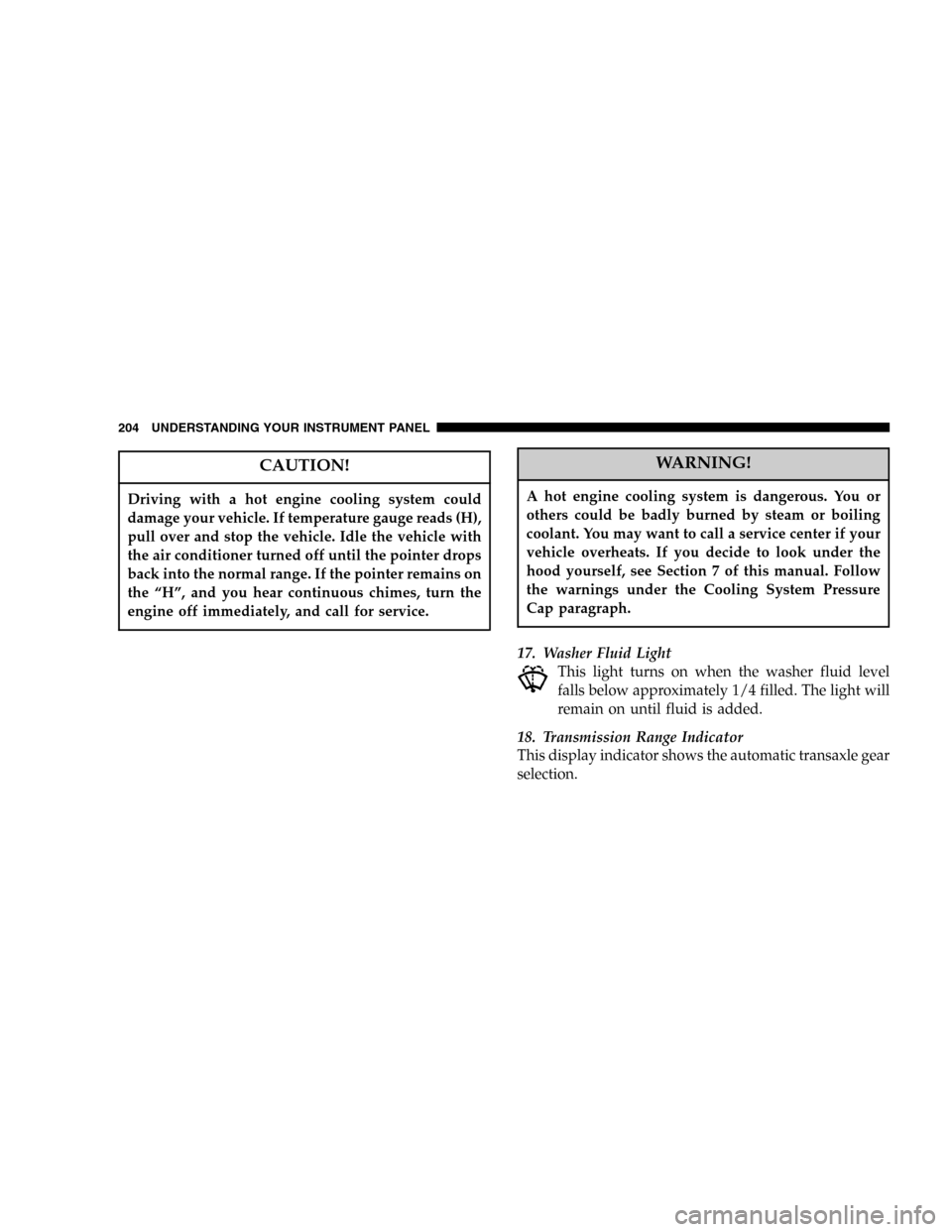Page 26 of 472

General Information
This device complies with part 15 of the FCC rules and
RSS 210 of Industry Canada. Operation is subject to the
following conditions:
•This device may not cause harmful interference.
•This device must accept any interference received,
including interference that may cause undesired op-
eration.
If your Remote Keyless Entry transmitter fails to operate
from a normal distance, check for these two conditions.
1. A weak battery in the transmitter. The expected life of
the battery is a minimum of three years.
2. Closeness to a radio transmitter such as a radio station
tower, airport transmitter, and some mobile or CB radios.
Transmitter Battery Service
The recommended replacement battery is one CR2032
battery.
NOTE:Do not touch the battery terminals that are on
the back housing or the printed circuit board.
1. With the transmitter buttons facing down, use a thin
coin to pry the two halves of the transmitter apart. Make
sure not to damage the rubber gasket during removal.
26 THINGS TO KNOW BEFORE STARTING YOUR VEHICLE
Page 83 of 472

While cruising, brief full-throttle acceleration, within the
limits of local traffic laws, contributes to a good break-in.
Wide open throttle acceleration in low gear can be
detrimental and should be avoided.
The engine oil installed in the engine at the factory is a
high quality energy conserving type lubricant. Oil
changes should be consistent with anticipated climate
conditions under which vehicle operations will occur.
The recommended viscosity and quality grades are
shown in Section 7 of this manual. NON-DETERGENT
OR STRAIGHT MINERAL OILS MUST NEVER BE
USED.
A new engine may consume some oil during its first few
thousand miles (kilometers) of operation. This should be
considered as a normal part of the break-in and not
interpreted as an indication of difficulty.SAFETY TIPS
Exhaust Gas
WARNING!
Exhaust gases can injure or kill. They contain carbon
monoxide (CO) which is colorless and odorless.
Breathing it can make you unconscious and can
eventually poison you. To avoid breathing (CO)
follow the safety tips below.
Do not run the engine in a closed garage or in confined
areas any longer than needed to move your vehicle in or
out of the area.
If it is necessary to sit in a parked vehicle with the engine
running, adjust your heating or cooling controls to force
outside air into the vehicle. Set the blower at high speed.
THINGS TO KNOW BEFORE STARTING YOUR VEHICLE 83
2
Page 84 of 472

WARNING!
If you are required to drive with the deck lid/liftgate
open, make sure that all windows are closed, and the
climate control blower switch is set at high speed.
DO NOT use the recirculation mode.
Safety Checks You Should Make Inside The
Vehicle
Seat Belts
Inspect the belt system periodically, checking for cuts,
frays and loose parts. Damaged parts must be replaced
immediately. Do not disassemble or modify the system.
Front seat belt assemblies must be replaced after a
collision. Rear seat belt assemblies must be replaced after
a collision if they have been damaged (bent retractor, torn
webbing, etc. If there is any question regarding belt or
retractor condition, replace the belt.
Airbag Light
The light should come on and remain on for 6
to 8 seconds as a bulb check when the ignition
switch is first turned ON. If the LED is not lit
during starting, have it checked. If the light
stays on or comes on while driving, have the system
checked by an authorized dealer.
Defroster
Check operation by selecting the defrost mode and place
the blower control on high speed. You should be able to
feel the air directed against the windshield.
84 THINGS TO KNOW BEFORE STARTING YOUR VEHICLE
Page 155 of 472

The lights also turn on when a front door, a sliding door
or the liftgate is opened. If your vehicle is equipped with
Remote Keyless Entry, the lights will also turn on when
the unlock button on the transmitter is pressed.
The area around the instrument panel cupholders is also
illuminated from a light in the overhead console. This
light is turned on when the headlight switch is on and
will adjust in brightness when the dimmer control is
rotated up or down.
Sunglass Storage
At the rear of the overhead console, a compartment is
provided for the storage of two pair of sunglasses.
Press the door latch to open the compartment. The door
will slowly rotate to an open position.
Compass/Temperature Display
This display provides the outside temperature and one of
eight compass readings to indicate the direction the
vehicle is facing.
WARNING!
Even if the display still reads a few degrees above
32°F(0°C), the road surface may be icy, particularly
in woods or on bridges. Drive carefully under such
conditions to prevent an accident and possible per-
sonal injury or property damage.
Automatic Compass Calibration
This compass is self calibrating which eliminates the
need to manually set the compass. When the vehicle is
new, the compass may appear erratic and the“CAL”
symbol will be displayed. After completing three 360°
UNDERSTANDING THE FEATURES OF YOUR VEHICLE 155
3
Page 193 of 472

�Satellite Radio—If Equipped..............258
▫System Activation.....................258
▫Electronic Serial Number/Sirius Identification
Number (ENS/SID)....................259
▫Selecting Satellite Mode In RBB, RAH And
RBK Radios.........................259
▫Selecting Satellite Mode In RBP, RBU, RAZ,
RB1 And RBQ Radios..................260
▫Selecting a Channel....................260
▫Storing And Selecting Pre-Set Channels......261
▫Using The PTY (Program Type) Button
(If Equipped)........................261
▫PTY Button�Scan�.....................261
▫PTY Button�Seek�.....................261▫Satellite Antenna......................261
▫Reception Quality.....................262
�Remote Sound System Controls—If Equipped . . 262
▫Radio Operation......................263
▫Tape Player.........................263
▫CD Player..........................264
�Cassette Tape And Player Maintenance.......264
�CD/DVD Disc Maintenance...............265
�Radio Operation And Cellular Phones........265
�Climate Controls.......................266
▫Manual Air Conditioning And
Heating System......................266
▫Front Mode Control...................267
UNDERSTANDING YOUR INSTRUMENT PANEL 193
4
Page 194 of 472
▫Manual Air Conditioning Operation........271
▫Manual Rear Zone Climate Control—
If Equipped.........................274
▫Infrared Three-Zone Automatic Temperature
Control—If Equipped.................276
�Rear Window Features...................288
▫Intermittent Rear Wiper Operation—Manual
Temperature Control Only...............288
▫Rear Washer Operation—Manual Temperature
Control Only........................289▫Rear Wiper Operation—Automatic Temperature
Control Only........................289
▫Intermittent Rear Wiper Operation—Automatic
Temperature Control Only...............290
▫Rear Washer Operation—Automatic Temperature
Control Only........................290
▫Electric Rear Window Defroster—
If Equipped.........................291
194 UNDERSTANDING YOUR INSTRUMENT PANEL
Page 199 of 472

INSTRUMENT CLUSTER DESCRIPTIONS
1. Fuel Gauge
The pointer shows the level of fuel in the fuel tank when
the ignition switch is in the ON position.
2. Tire Pressure Monitor Warning Light—If Equipped
This light will turn on when there is a Low tire
pressure condition. The light will remain on
until the tire pressure is properly set. The light
will also flash if a problem exist with any tire
sensor. The light will flash for approximately three sec-
onds every 10 minutes or until the problem with the
sensor is corrected.
This light will turn on momentarily as a bulb check when
the engine is started.
When the tire pressure monitoring system warning light
is lit, one or more of your tires is significantly underin-
flated. You should stop and check your tires as soon aspossible, and inflate them to the proper pressure as
indicated on the tire and loading information placard.
Driving on a significantly underinflated tire causes the
tire to overheat and can lead to tire failure. Underinfla-
tion also reduces fuel efficiency and tire tread life, and
may affect the vehicle’s handling and stopping ability.
Each tire, including the spare, should be checked
monthly when cold and set to the recommended inflation
pressure as specified in the tire and loading information
placard and owner’s manual.
NOTE:If one of the vehicle active tires has been
replaced by the spare or a wheel rim not equipped with
a TPM sensor, the tire pressure monitor warning light
will flash for approximately three seconds every 10
minutes. Repair or replace the tire or sensor as soon as
possible.
UNDERSTANDING YOUR INSTRUMENT PANEL 199
4
Page 204 of 472

CAUTION!
Driving with a hot engine cooling system could
damage your vehicle. If temperature gauge reads (H),
pull over and stop the vehicle. Idle the vehicle with
the air conditioner turned off until the pointer drops
back into the normal range. If the pointer remains on
the“H”, and you hear continuous chimes, turn the
engine off immediately, and call for service.
WARNING!
A hot engine cooling system is dangerous. You or
others could be badly burned by steam or boiling
coolant. You may want to call a service center if your
vehicle overheats. If you decide to look under the
hood yourself, see Section 7 of this manual. Follow
the warnings under the Cooling System Pressure
Cap paragraph.
17. Washer Fluid Light
This light turns on when the washer fluid level
falls below approximately 1/4 filled. The light will
remain on until fluid is added.
18. Transmission Range Indicator
This display indicator shows the automatic transaxle gear
selection.
204 UNDERSTANDING YOUR INSTRUMENT PANEL